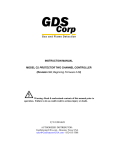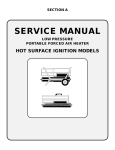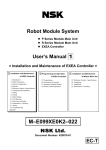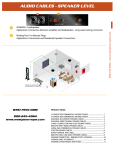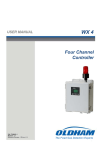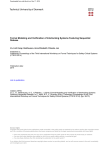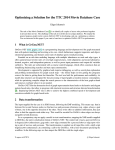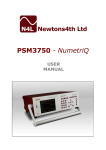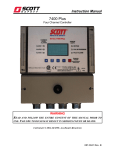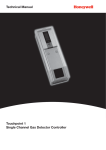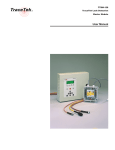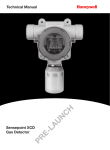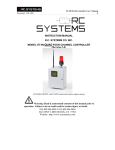Download HA20 Manual
Transcript
HA20 2-Channel Controller
HA20 Display & Alarm Controller
Two Channel
Channel 1
Channel 2
A1
A1
A2
A2
A3/Fault
A3/Fault
Magnetic
Cal
Next
Edit
Keypad
Alarm
Reset (Keypad buttons
behind door)
Power = 100-240 V~, 50/60 Hz, .45 A
or 10-30 VDC @ 3 WATTS
219995
Technical Manual
Version 2.08 and up
Classified to CSA C22.2 NO. 152 for combustibles
detection. Class I, DIV.2, Groups A,B,C,D
READ & UNDERSTAND MANUAL!
S/N 90-
HA20 2-Channel Controller
Safety
combustibles using mA input.
• This equipment is suitable for use in Class I, Division 2, Groups
A,B,C and D or non-hazardous locations only.
Warning
• EXPLOSION HAZARD- SUBSTITUTION OF COMPONENTS MAY
IMPAIR SUITABILITY FOR CLASS I, DIVISION 2.
Read and understand contents of this manual prior to operation.
Failure to do so could result in serious injury or death.
• EXPLOSION HAZARD- DO NOT REPLACE FUSE UNLESS POWER
HAS BEEN SWITCHED OFF OR THE AREA IS KNOWN TO BE NONHAZARDOUS.
IMPORTANT SAFETY
The following terms and symbols are used in this manual to alert the
operator of important instrument operating issues:
• EXPLOSION HAZARD- DO NOT DISCONNECT EQUIPMENT UNLESS
POWER HAS BEEN SWITCHED OFF OR THE AREA IS KNOWN TO
BE NON-HAZARDOUS.
This symbol is intended to alert the user to the presence
of impor tant operating and maintenance (servicing)
instructions.
This symbol is intended to alert the user to the presence of
dangerous voltage within the instrument enclosure that may be
of sufficient magnitude to constitute a risk of electric shock.
Cautions
• Use a properly rated CERTIFIED AC power (mains) cable
installed as per local or national codes.
• For DC powered units, DC power must be from a SELV rated
source.
This symbol signifies the system’s ground terminal
• A certified AC power (mains) disconnect or circuit breaker
should be mounted near the controller and installed according
applicable local and national codes. If a switch is used instead
of a circuit breaker, a properly rated CERTIFIED fuse or current
limiter is required to be installed as per local or national
codes. Markings for positions of the switch or breaker should
state (I) for on and (O) for off.
DC refers to direct current voltages.
VAC refers to alternating voltages.
WARNINGS
• Shock Hazard - Disconnect or turn off power before servicing
this instrument.
• Clean using only a damp cloth with no solvents.
• NEMA 4X wall mount models should be fitted with a locking
mechanism after installation to prevent access to high voltages
by unauthorized personnel (see Figure 4-1).
• Equipment not used as prescribed within this manual may
impair overall safety
• Only the combustible monitor portions of this instrument have been
assessed by CSA for 122.2 No. 152 performance requirements (for
HA20 Technical Manual
i
Revision 1 (07/08)
HA20 2-Channel Controller
Table of Contents
Safety����������������������������������������������������������������������������������������������������������������������������������������������������������������������������������������i
1 General Description
1 General Description����������������������������������������������������������������������������������������������������������������������������������������������������������1-2
1.1 Data Display Screens����������������������������������������������������������������������������������������������������������������������������������������������1-3
1.1.1 Main Data Screen���������������������������������������������������������������������������������������������������������������������������������������������1-3
1.1.2 Trend Screen�����������������������������������������������������������������������������������������������������������������������������������������������������1-3
1.1.3 Blind Mode Screen��������������������������������������������������������������������������������������������������������������������������������������������1-3
1.3 Specifications����������������������������������������������������������������������������������������������������������������������������������������������������������1-3
1.3.1 Power Supply Requirements�����������������������������������������������������������������������������������������������������������������������������1-3
1.3.2 Relays���������������������������������������������������������������������������������������������������������������������������������������������������������������1-4
1.3.3 Ambient Temperature Range ���������������������������������������������������������������������������������������������������������������������������1-4
1.3.4 Humidity Range������������������������������������������������������������������������������������������������������������������������������������������������1-4
1.3.5 Altitude��������������������������������������������������������������������������������������������������������������������������������������������������������������1-4
1.3.6 Housings / Installation Categories��������������������������������������������������������������������������������������������������������������������1-5
1.3.7 Approvals����������������������������������������������������������������������������������������������������������������������������������������������������������1-5
HA20 Technical Manual
ii
Revision 1 (08/08)
HA20 2-Channel Controller
2 Operation
2 Operation���������������������������������������������������������������������������������������������������������������������������������������������������������������������������2-2
2.1 Setup Menu Configuration��������������������������������������������������������������������������������������������������������������������������������������2-2
2.2 Changing Menu Variables Using The Keypad��������������������������������������������������������������������������������������������������������2-3
2.2.1 Setup Configuration Menus������������������������������������������������������������������������������������������������������������������������������2-3
2.2.2 Channel Setup Entry Menu�������������������������������������������������������������������������������������������������������������������������������2-3
2.2.3 Alarm 1 / Alarm 2 / Alarm 3 Set-Up Menus�������������������������������������������������������������������������������������������������������2-3
2.2.4 Using the Configure Menu to Define Channel��������������������������������������������������������������������������������������������������2-4
Name / Eunits ASCII Data Fields�������������������������������������������������������������������������������������������������������������������������2-4
Input Measurement Range����������������������������������������������������������������������������������������������������������������������������������2-5
Decimal Point Resolution�������������������������������������������������������������������������������������������������������������������������������������2-5
Turning Off Unused Channels������������������������������������������������������������������������������������������������������������������������������2-5
2.2.5 CAL Setup Menu�����������������������������������������������������������������������������������������������������������������������������������������2-5
2.2.6 Calibrate Input Menu�����������������������������������������������������������������������������������������������������������������������������������������2-6
2.3 System Configuration Menus���������������������������������������������������������������������������������������������������������������������������������2-7
2.3.1 Relay 1 / Relay 2 Menus�����������������������������������������������������������������������������������������������������������������������������������2-7
2.3.2 Horn / Piezo Menu��������������������������������������������������������������������������������������������������������������������������������������������2-8
2.3.3 Comm Port Menu����������������������������������������������������������������������������������������������������������������������������������������������2-8
2.3.4 Clock / Delays Menu�����������������������������������������������������������������������������������������������������������������������������������������2-9
2.3.5 Diagnostics Menu���������������������������������������������������������������������������������������������������������������������������������������������2-9
2.4 System Security Menu������������������������������������������������������������������������������������������������������������������������������������������2-10
HA20 Technical Manual
iii
Revision 1 (08/08)
HA20 2-Channel Controller
3 Motherboard Interface PCB
3 Motherboard Interface PCB���������������������������������������������������������������������������������������������������������������������������������������������3-2
3.1 Input / Output Optional PCB’s��������������������������������������������������������������������������������������������������������������������������������3-3
3.1.1 Optional Analog Input PCB�������������������������������������������������������������������������������������������������������������������������������3-3
3.1.2 Optional Discrete Relay PCB’s�������������������������������������������������������������������������������������������������������������������������3-4
3.1.3 Optional 4-20mA Analog Output Board������������������������������������������������������������������������������������������������������������3-5
3.2 Modbus RS-232 / RS-485 Interface Option������������������������������������������������������������������������������������������������������������3-6
3.2.1 Modbus Register And Function Code Summary�����������������������������������������������������������������������������������������������3-7
4 Enclosures
4 Enclosures������������������������������������������������������������������������������������������������������������������������������������������������������������������������4-2
4.1 HA20N4 NEMA 4X Wall Mount Enclosure��������������������������������������������������������������������������������������������������������������4-2
4.2 HA20XP NEMA 7 Explosion-Proof Wall Mount Enclosure�����������������������������������������������������������������������������������4-2
5 Parts List
5 Parts List���������������������������������������������������������������������������������������������������������������������������������������������������������������������������5-2
6 Specifications
5 Specifications�������������������������������������������������������������������������������������������������������������������������������������������������������������������6-2
7 Warranty
Honeywell Analytics Warranty Statemen���������������������������������������������������������������������������������������������������������������������������7-2
HA20 Technical Manual
iv
Revision 1 (08/08)
HA20 2-Channel Controller
HA20 Technical Manual
v
Revision 1 (08/08)
HA20 2-Channel Controller
1 General Description
HA20 Technical Manual
1-1
Revision 1 (08/08)
HA20 2-Channel Controller
1 General Description
The Honeywell Analytics HA20 2-Channel Controller is designed to
display, and control alarm event switching for two inputs. Inputs are
typically voltage or 4-20mA current from transmitters, monitors or
other analog output devices. The HA20 is equipped with a Fault and
three alarm levels per channel with features such as ON / OFF delays,
latching relays and alarm Acknowledge. A dedicated horn driver circuit
for a local audible annunciator is also standard. Two standard 5-amp
alarm relays are configurable via the “alarm voting” menu to make
relays trip based on various alarm combinations. A real-Time Clock
and Calendar are also standard. Options such as 4-20mA outputs,
discrete relays for each alarm and audible annunciators are easily
added. RS-485 (Modbus RTU) or Ethernet (Modbus TCP) ports
are also available for sending data to PC’s, PLC’s, DCS’s, or other
Honeywell Analytics controllers.
A 128 x 64 pixel graphic LCD readout displays monitored data as bar
graphs, 30-minute trends and engineering units. System configuration
is via user friendly menus and all configuration data is retained in nonvolatile memory during power interruptions. The HA20 front panel
shown in Figure 1-1 displays the bar graph data screen. The five
button symbols below the display are magnetically activated using the
magnetic wand (supplied) without opening the enclosure. Opening
the enclosure door provides access to the “touch” keypad as shown
in Figure 1-2.
HA20 Technical Manual
1-2
HA20 Display & Alarm Controller
Two Channel
Channel 1
Channel 2
A1
A1
A2
A2
A3/Fault
A3/Fault
Magnetic
Cal
Next
Keypad
Alarm
Reset (Keypad buttons
behind door)
Edit
Power = 100-240 V~, 50/60 Hz, .45 A
or 10-30 VDC @ 3 WATTS
S/N 90-
Classified to CSA C22.2 NO. 152 for combustibles
detection. Class I, DIV.2, Groups A,B,C,D
READ & UNDERSTAND MANUAL!
219995
Figure 1-1. Front Panel
Piezo
Ch2 Alarm LEDs
Ch1 Alarm LEDs
LCD readout contrast
adjustment
UP
DOWN
NEXT
EDIT
RESET
SW1-SW5 are the magnetic keypad allowing operator
interface w/o opening the enclosure. Touch key access requires
opening the enclosure.
Figure 1-2. Front Panel Display (open enclosure)
Revision 1 (08/08)
HA20 2-Channel Controller
1.1 Data Display Screens
1.1.3 Blind Mode Screen
The HA20 Controller offers three modes for displaying monitored data,
as shown in Figure 1-3.
The HA20 Blind Mode screen (Figure 1-3) does not allow viewing of
channel engineering unit values. It only indicates the system’s alarm
status and time / date. Some applications require only alarm status be
displayed and prefer monitored values not be shown. A SECURITY
menu (see Section 2.4) allows locking all configuration parameters
and having only the Blind Mode screen available for viewing.
1.3 Specifications
1.3.1 Power Supply Requirements
Figure 1-3. Data Display Screens
1.1.1 Main Data Screen
The HA20 Main Data screen shown in Figure 1-3 allows each channel
to be viewed simultaneously. Engineering unit values and bar graph
values are both displayed in real time. Arrows below the bars indicate
alarm trip point values, making it easy to identify channels at or
near alarm level. The direction the horizontal 45º side arrow points
indicates either a HIGH or LOW trip point. In Figure 1-1 where Ch 1
points right indicating high trip levels and Ch 2 points left indicating
low trip levels. Left and Right hand arrows located at the ends of
each bar graph point towards Channel Alarm LED’s on the front panel
associated with this reading. The 10-digit ASCII fields for identifying
engineering units and Channel ID for each channel are also shown
on the Main Data screen.
The HA20 is equipped with an integral 15 watt universal AC input /
24 VDC output switching power supply. Standard HA20 AC power
requirements are 100-240 VAC 50/60 Hz @ .45 amp max (including
inrush) and 20 watts steady state, applied to TB5 on the motherboard. If
AC power is not available, the HA20 may also be powered with 24 VDC
applied to TB1 on the motherboard. A primary DC source or back-up
DC source capability should be determined by the total system power
budget calculation with guard-band included. A back-up DC power
source may also be connected to TB1 for automatic switchover if the
AC power source fails. See Figures 3-1 & 3-2 for wiring information.
Warning
A back-up or external DC power source DOES NOT source aux power
output (TB3 - see Figure 3.1)
1.1.2 Trend Screen
In addition to the Main Data screen described above, the HA20 also
provides 30-minute trend screens for each channel as shown in Figure
1-3. Use the Next key to scroll between data screens.
HA20 Technical Manual
1-3
Revision 1 (08/08)
HA20 2-Channel Controller
The basic HA20 consumes only 1.5 watts of 10-30 VDC from the
integral power supply.
Optional features, and external devices such as remote transmitters,
increase power consumption as described below:
• Discrete Relay PCB option; add 1.5 watt.
• 4-20mA Output PCB option; add .5 watt.
• TB3 terminals 1 & 2 on the motherboard provide a maximum
of 350mA output power for powering of auxiliary external
devices such as relays, lamps or transmitters (see Figure 3-1).
Power consumed from these terminals must be included when
calculating system power consumption.
1.3.2 Relays
Two mechanical (dry contact) Common Form C relays are standard and
may be mapped to various alarm events as described in Section 2.3.1.
HA20’s may also be equipped with optional solid-state common Form
A relays (see Section 5 - Specifications for details) in applications
requiring non-arcing switching. Solid-state relays are recommended
for switching of highly inductive loads.
A six mechanical (dry contact) Discrete Relay option board (see
Section 3.1.6) provides dedicated Form C relays for ALARM 1, ALARM
2 and FAULT for all channels.
Warning
• 10-0221-2, Analog Input PCB option; add wattage for each
monitor connected to this board’s 24 VDC terminal
Some applications require the HA20 controller to source power for high
power monitors. If the integral 15 watt power in not enough, a 24VDC,
50 watt power supply, UL rated for Div 2 hazardous areas is available.
This option is also available with a Div 1 enclosure if an explosionproof enclosure is required. (See Section 5 - Specifications.)
Warning
A backup, or external DC power source DOES NOT source auxiliary
power output (see figure 3.1 TB3).
All mechanical (dry contact) relays are rated at 5 Amp for 28 VDC
and 250 ~VAC RESISTIVE loads. IMPORTANT: Appropriate diode (DC
loads) or MOV (AC loads) snubber devices must be installed with
inductive loads to prevent RFI noise spikes.
Optional solid state relays are rated at 2 Amp 12-280~VAC (600Vpk).
Relay wiring should be kept separate from low level signal wiring.
1.3.3 Ambient Temperature Range
-25 to 50 degrees C
1.3.4 Humidity Range
0 to 90% R. H. Non-Condensing.
1.3.5 Altitude
Recommended up to 2000 meters
HA20 Technical Manual
1-4
Revision 1 (08/08)
HA20 2-Channel Controller
1.3.6 Housings / Installation Categories
•
• *NEMA 4X wall mount. DIV 2 Groups A,B,C,D; Category II and
pollution degree 3; NEMA 4X; IP66
• *NEMA 7 wall mount for DIV 1 & 2 Groups B,C,D; includes
o-ring in door to satisfy NEMA 4 rating.
*Includes standard non-intrusive magnetic keypad.
1.3.7 Approvals
• CSA C22.2 No 1010.1 and ISA S82.02
• CSA C22.2 No 152 for combustibles (mA input only)
• UL 1604 / C22.2 No 213 (Div 2 Groups A,B,C,D)
• EN55011 & EN61000 (CE Mark). CSA File # = 219995 and
may be seen at: www.CSA-International.org.
HA20 Technical Manual
1-5
Revision 1 (08/08)
HA20 2-Channel Controller
2 Operation
HA20 Technical Manual
2-1
Revision 1 (07/08)
HA20 2-Channel Controller
2 Operation
HA20 Dual Channel Controller Menu Tree
The HA20’s graphic LCD displays monitored data. The 5-button
keypad and the display serve as the system’s operator interface.
All configuration variables are entered using this operator interface
through SETUP menus accessed by pressing Edit from either data
screen. This Setup mode may be exited manually by pressing Next,
or automatically when no keys are pressed for 5 minutes. Alarm
relays and front panel alarm LED indicators remain active during the
Setup mode. Alarm LED’s flash upon new alarms and become steady
after Acknowledged by pressing the Alarm Reset key. A SECURITY
menu offers a password feature to prevent tampering with HA20
parameters.
A “sign-on” screen appears briefly after power is applied that indicates
what type of input / output options are configured with the unit.
Several signal conditioning input options are available to allow the
HA20 to accept sensor and other analog signals directly (see Section
3.1).
2.1 Setup Menu Configuration
Variables within the CHANNEL (see Section 2.2) and SYSTEM (see
Section 2.3) menu trees allow HA20 configuration of a wide range of
monitoring applications. Select the desired menu by scrolling with Up/
down arrows and then Edit to enter each menu. Figure 2-1 illustrates
the menu tree configuration with Channel variables on the left and
System variables on the right. Channel variables affect only the specific
channel selected while System variables are related to features not
specific to either channel.
Figure 2-1. Menu Tree
HA20 Technical Manual
2-2
Revision 1 (07/08)
HA20 2-Channel Controller
2.2 Changing Menu Variables Using The
Keypad
2.2.1 Setup Configuration Menus
The SETUP menu shown in the middle of Figure 2-1 and in Figure
2-2 is reached by pressing Edit with any data display present. This is
the entry-level screen to all Channel, System and Security menus. It
also shows the firmware version operating in the HA20. Use the up/
down arrows keys to move the pointer to the desired menu and press
the Edit key to select.
Magnetic
Cal
Next
Edit
Keypad
Alarm
Reset (Keypad buttons
behind door)
Figure 2-1. Keypad
Upon entering a menu, a pointer controlled by the up/down arrow keys,
indicates the selected variable. Some are simple YES/NO or ON/OFF
entries toggled by pressing the Edit key. Others, such as Channel ID
and Eunits fields, may have many ASCII character possibilities. Allowed
ASCII characters are as follows:
ABCDEFGHIJKLMNOPQRSTUVWXYZ
abcdefghijklmnopqrstuvwxyz
blank space
!”#$%&`()*+,-./0123456789:;<=>?@[\]^_`.
Figure 2-2. Setup Configuration Menu
2.2.2 Channel Setup Entry Menu
Notice the often used blank character is located after lower case z
and before the exclamation point !. Edit places a cursor under the item
and up/down arrow scroll through each allowed entry. The Next key
moves the cursor to the next position within a field. When the field is
complete, Edit clears the cursor and loads the field into non-volatile
memory where it is retained indefinitely. Without a cursor present, the
Next key closes open menus in reverse order and returns the LCD to
the data display.
The Channel x SETUP menu shown in Figure 2-3 allows configuration
of all variables for the selected channel. These are Alarm 1, Alarm 2,
Alarm 3, Configure and CAL Setup.
Figure 2-3. Channel Setup Entry Menu
2.2.3 Alarm 1 / Alarm 2 / Alarm 3 Set-Up Menus
Alarm 1, 2 and 3 have identical menus. The only difference is that
A1 LED indicators are yellow while A2’s and A3’s are red. Typical
applications often have A1 set at a WARN level, A2 at a HIGH level and
A3 at a negative FAULT level. However, it is important to understand
there is no functional difference between A1, A2 and A3, therefore
only one is shown in Figure 2.4.
HA20 Technical Manual
2-3
Revision 1 (07/08)
HA20 2-Channel Controller
alarm. Any new alarm event causes the associated LED to flash until
an Alarm Reset occurs causing an acknowledged steady on condition.
Operators should recognize new alarms by a flashing LED. Alarm
Reset also acknowledges, or deactivates, audible devices driven by
the AUDIBLE ALARM option connector J2 (see Figure 3.2)
Figure 2-4. Alarm Setup Menu
• Set Point is entered in engineering units and determines
the value at which the alarm trips. For example, if a channel
monitors 0-50 ppm H2S and the desired alarm level is 10 ppm,
the correct entry is 10.00. A one percent deadband prevents
alarm chatter. This means after tripping an alarm the input must
move at least 1% of full scale back through the setpoint for the
alarm to auto reset.
• The ON Delay / OFF Delay entries allow ON and OFF time
delays affecting how long the trip-point must be surpassed
before an alarm event transition occurs. ON delays are limited
to 10 seconds while OFF delays may be as long as 120
minutes. Delays are useful in many applications to prevent
nuisance alarms and unwanted cycling into and out of alarm
conditions.
• Low Trip is set to NO to increase alarms or YES to decrease
alarms, which determines if the alarm activates upon exceeding
or falling below the set-point.
• Latching determines either manual or automatic alarm reset
operation. YES requires a manual Alarm Reset to unlatch the
alarm even though an alarm condition no longer exists. YES
also causes this alarm’s common relay, front panel LED, and
optional discrete relay to latch. NO allows all outputs for this
alarm to automatically reset after the alarm condition clears.
2.2.4 Using the Configure Menu to Define Channel
The next menu option, after the Alarm Setup option, is Configure.
It allows setting Name and EUNIT fields, defining the measurement
range (Zero and Span), how many decimal points of resolution the
reading will have and whether the channel is active (Figure 2.5).
Figure 2-5. Configure Menu - Define Channel
Name / Eunits ASCII Data Fields
The first two items in this menu, Name and EUNIT, are for entering
the 10 character channel Name and engineering unit ASCII fields.
Name should describe the channel’s data in user terminology such as
tag # or other description. Eunits should define the units of measure
for what this channel is to display. Several standard Eunits fields are
available by pressing Edit but if these are inappropriate, a CUSTOM
field allows editing of each character. Section 2.2 describes how to
modify these fields using the keypad.
Discrete LED indicators on the front panel indicate the status of each
HA20 Technical Manual
2-4
Revision 1 (07/08)
HA20 2-Channel Controller
Input Measurement Range
2.2.5 CAL Setup Menu
The ZERO / SPAN menu options allow configuration of the
measurement range displayed by this channel. Measurement Range
defines the range of the input signal’s engineering units. For example,
if a channel’s input is 4-20mA from a transmitter monitoring 0 to 10ppm
chlorine, then the Zero value should equal 0.000 and the Span value
equal 10.00. Four digits must be entered so trailing 0’s may appear
here that are not displayed on other data screens.
The CAL SETUP feature supports pushbutton calibration of zero
and span values. This feature should only be utilized when there are
no other zero/span controls within the monitoring system since it is
inappropriate to calibrate a signal at more than one point.
Decimal Point Resolution
Resolution of the displayed channel value is configured in the Decimal
Pts. menu by setting the number of digits trailing the decimal point.
Displayed readings are limited to a maximum of four digits with a
polarity sign. Auto-ranging displays the highest resolution allowed by
this menu’s decimal point entry. For example, a range of 0 to 100ppm
and two decimal points reads 0.00 at 0ppm and 100.0 at 100ppm.
This may be undesirable due to the high resolution at zero unless
the sensor’s output is extremely stable. If decimal points are limited
to one, the 0ppm reading becomes 0.0 and the 100ppm reading
remains 100.0.
Therefore, if calibration will be performed at another transmitter or
monitoring device, the CAL MODE feature should not be used.
The CAL SETUP menu allows entering the correct Zero Gas & Span
Gas set-point values needed to calibrate the sensor. These are entered
in the same engineering units as the input range.
Figure 2-6. Cal Setup Menu
Resolution may be limited further by setting decimal points to 0 where
in the above example, 0ppm reads 0 and 100ppm reads 100.
Turning Off Unused Channels
The Channel Active menu entry asks if this channel is to be utilized.
OFF causes the controller to never process inputs applied to this
channel and no alarms are tripped or data displayed. Inactive channels
have a line drawn through them on the Setup screen to indicate they
are turned off.
HA20 Technical Manual
2-5
Revision 1 (07/08)
HA20 2-Channel Controller
2.2.6 Calibrate Input Menu
Calibration is the most important function for ensuring correct operation
of HA20s equipped with sensor inputs. The CAL MODE (flow chart
shown in Figure 2-7) is designed to make calibration quick, easy and
error free. A successful ZERO and SPAN calibration requires only five
keystrokes. Optional 4-20mA outputs (if equipped) transmit 1.5mA
during CAL MODE and 4mA during the subsequent CAL PURGE
delay to prevent external alarms during calibration. Local HA20 alarm
relays are inhibited during CAL MODE. Unintentional calibrations
may be reset using the Set UNITY menu item. Set UNITY resets
CAL OFFSET to 0 & CAL GAIN to 1 which is useful for returning the
calibration to a known starting place. Sensor aging may be monitored
by recording zero and span readings at Unity Gain when the sensor is
new, and again later when degradation may have occurred. CAL MODE
automatically exits if no keystroke is detected after 5 minutes.
Use the following step-by-step procedure to perform ZERO and SPAN
calibrations.
WARNING
Follow these sensor calibration guidelines:
• Calibration accuracy is only as good as the calibration standard
accuracy. Honeywell Analytics recommends calibration
standards with NIST (National Institute of Standards and
Technology) traceable accuracy to increase the validity of the
calibration.
• Do not use a gas cylinder beyond its expiration date.
• Calibrate a new sensor before use.
• Allow the sensor to stabilize before starting calibration. (Consult
the appropriate sensor manual for warm-up times.)
• Calibrate on a regular schedule. (Consult the appropriate sensor
manual for calibration intervals or depending on use and sensor
exposure to poisons and contaminants.)
• Calibrate only in a clean atmosphere free of background gas.
HA20 Technical Manual
1. To enter the CAL MODE from any data display, press the dual
purpose down arrow/CAL key and press the Edit key within 5
seconds then select channel.
2. Using the Cal-Cup and following the instructions on the screen,
apply a clean ZERO gas or be sure there is no background
target gas in the monitored area. After the reading is stable,
(approximately 1 minute) press the Edit key to perform a ZERO
calibration.
3. If the ZERO calibration is successful, CAL MODE automatically
proceeds to the SPAN check.
4. Apply the correct SPAN calibration standard. After the reading
is stable, press the Edit key to perform a SPAN calibration.
2-6
The SPAN gas used must match the value specified since this is what
the HA20 will indicate after a successful SPAN calibration. The Span
Gas value may be edited if it becomes necessary to apply a different
gas concentration (see Figure 2.6 [Span Gas] in Section 2.2.5).
5. If the SPAN calibration is successful, the display flashes
“REMOVE CAL GAS” and starts the CAL PURGE delay.
6. CAL MODE will be complete after the end of the CAL PURGE
delay.
Revision 1 (07/08)
HA20 2-Channel Controller
The flow chart in Figure 2-7 illustrates the above procedure. up arrow,
CAL, Next & Edit labels indicate keystrokes (down arrow/CAL is a dual
purpose key). The CAL MODE information screen (top of the chart) is
available for advanced users to see Offset / Gain calibration constants
and live analog to digital converter (A/D) counts. Span Gas calibration
values may also be edited from this screen. Holding the up arrow key
for 5 seconds during CAL MODE displays this screen.
Unity Gain may be used at anytime to cancel incorrect calibrations
and start again.
2.3 System Configuration Menus
Several items needing configuration are not specific to either channel
but affect the entire system. These are located in the system tree
entry menu shown on the left side of Figure 2-1. System menus
are accessed by pointing to the desired item and pressing Edit. The
Diagnostics menu group (\) is useful for testing relay and analog I/O
without stimulating the input.
Figure 2-8. System Configuration Menu
2.3.1 Relay 1 / Relay 2 Menus
Figure 2-7. Cal Mode Flow Chart
The Relay 1 & Relay 2 menus are identical except Relay 2 has an
acknowledge feature that is useful if it controls an audible device.
All other Relay 1 & Relay 2 features are identical and therefore are
discussed only once.
Figure 2-9. Relay Menus
• The Set Relay Logic menu shown below in Figure 2-10 offers
additional “voting” flexibility by controlling the channel alarm
combinations that will trip this common alarm relay. “OVR” on
the menu’s right side stands for override and means ANY of the
selected alarms will activate the relay. The “OR” / “AND” columns
work together based upon the following logic equation:
HA20 Technical Manual
2-7
Revision 1 (07/08)
HA20 2-Channel Controller
[AND column selections] ANDED WITH [OR column selections] = relay
activation.
For example, if Ch1A1 & Ch2A1 are selected in the AND column and
Ch1A2 & Ch2A2 are selected in the OR column, the logic equation
is [Ch1A1 AND Ch2A1] ANDED WITH [Ch1A2 OR Ch2A2]. This
requires both A1s along with either A2 to activate the relay.
2.3.2 Horn / Piezo Menu
• The HA20 display PCB is equipped with a small audible piezo
(P/N 1000-1892, NEMA 4X housing only) that chirps when keys
are pressed providing an audible feedback to the operator. It also
may be set to audibly indicate alarm conditions by selecting YES
in the Piezo On menu option (Figure 2-11). This piezo will then
mimic the Horn settings menus described in Section 2.3.1.
• The Horn ACK menu item determines if the Horn Driver output
may be acknowledged by an Alarm Reset. YES causes an
Alarm Reset to silence the horn even though an alarm condition
remains active.
Figure 2-10. Set Relay Logic
• Failsafe controls relay activation for the common relays. Failsafe
ON causes these relays to de-energize during alarm conditions
and energize when there is no alarm.
With Failsafe active, a power failure forces the relay contact to
the alarm position.
• Horn controls how activating this relay will affect the horn driver
circuit connected to J2 on the motherboard. Choices are NO,
STEADY or PULSE (Ex.: The horn can be set to Pulse for
warning. alarm levels and set to Steady for high alarm levels. Thus,
personnel can know which alarm level is present by based on the
pulsing or steady horn).
• Turning Acknowledge ON (not allowed on Relay 1) allows Relay
2 to be deactivated by an Alarm Reset during alarm conditions.
This is useful if another audible device is being driven by the
relay. The acknowledge feature is not available for Relay 1 since
it is often used for driving a warning light and Relay 2 for driving
a horn. Using Acknowledge (thus deactivating) when horn and
light are activated could be dangerous since this deactivates
both and no indication of the High alarm remains.
HA20 Technical Manual
Figure 2-11. Horn/Piezo Menu
2.3.3 Comm Port Menu
The system Comm Port menu allows setting RTU address for the
optional slave Modbus serial port. This slave port may be used to
transfer HA20 data to a host device such as a PC, PLC, DCS or even
another Honeywell Analytics Controllers. The slave port is addressable,
allowing many HA20 controllers to be connected to a single RS-485
cable.
2-8
Figure 2-12. Communication Port Menu
Revision 1 (07/08)
HA20 2-Channel Controller
2.3.4 Clock / Delays Menu
• The HA20 monitors signals from sensors that may require
varying times to stabilize after power is applied. The Startup
Delay menu item allows setting how long alarm relays remain
disabled after power is applied.
• Cal Delay determines how long alarm relays are inhibited after
completing a calibration.
• The HA20 is equipped with a 24-hour clock and calendar. Time
and Date menu items are for setting the correct time and date.
Time of day must be entered in 24 hour mode. For example,
6:00:00 PM = is indicated as18:00:00.
menu items may also be used to drive 4-20mA into receiver devices
without stimulating sensor inputs.
Input Min / Max ADC (analog to digital converter) menu items are
set at the factory with default values for each channel of 200 to 1000
counts. These settings may be utilized to affect what input values
provide ZERO and SPAN readouts. For example, if an application
required 8mA input to read ZERO at 400 counts, an Input Min setting
of 400 would accomplish this.
Common Relays menu item allows manual activation of the common
relays and optional local audible piezo.
Discrete Relays menu item allows manual activation of the optional
10-0222 Discrete Relay boards.
Figure 2-13. Clock/Delay Menu
Figure 2-14. Diagnostics Menu
2.3.5 Diagnostics Menu
WARNING
Alarm processing is halted with the Diagnostics mode active.
The Diagnostics menu (Figure 2-14) is useful for testing standard and
optional Input / Output devices such as relays and 4-20mA outputs.
Diagnostic menu items are described below:
Output Zero / Output Span DAC value (digital to analog converter)
menu items are set at the factory to calibrate optional 10-0223 4-20mA
Output boards. If field adjustment is required, monitor the 4-20mA
output and set the Output Zero DAC value for 4mA on each channel
then set the Output Span DAC value for 20mA on each channel. These
HA20 Technical Manual
2-9
Revision 1 (07/08)
HA20 2-Channel Controller
2.4 System Security Menu
A 4-digit Pass Code entered and confirmed in this menu item locks
all menus. Viewing menus is not denied but attempts to edit variables
flashes the Locked message on the LCD.
Authorized individuals locking the system should first enter a name,
phone #, or other contact information in the 12 character field on the
top line of the System SECURITY screen. To lock or unlock the system
the correct 4 digit authorization number must be entered into the Pass
Code field. It is very important to remember the 4 digit code since the
factory must be consulted if it is lost.
Figure 2-15. System Security Menu
HA20 Technical Manual
2-10
Revision 1 (07/08)
HA20 2-Channel Controller
3 Motherboard Interface PCB
HA20 Technical Manual
3-1
Revision 1 (08/08)
HA20 2-Channel Controller
3 Motherboard Interface PCB
(P/N 10-0215)
U niversal Input
Pow er Supply
The HA20 Motherboard shown in Figure 3.2 is the interface between
the Display / CPU assembly and all other system I/O devices. The
Display / CPU assembly attaches to the motherboard with 4-standoffs
and connects via ribbon cable to S1. Several input options, described
in the following sections, are available that may be installed into the
Sensor Input Option P1 connector located on the lower left side of
the motherboard. The middle position P2 connector is for the 10-0223
4-20mA Output option and the right position P3 connector is for the
10-0222 Discrete Relay option. Other option devices such as Modbus
RTU RS-485, Ethernet and a data logger may also be installed to
connectors located on the Motherboard.
The Motherboard PCB contains a 24 VDC universal input (100240 VAC) switching power supply with up to 350mA available at
TB3 Auxiliary Power Output terminals (Figure 3.1). If AC power is
unavailable, or if a DC battery back-up supply is needed, TB1 provides
terminals for DC power input. Blocking diodes isolate internal and
external DC supplies as shown in Figure 3-1.
HA20 Technical Manual
D C Out
+
2 Amp, 250V, 5x20mm fuse located under
terminal cover.
WARNING: For continued protection against
fire replace only with same type and rating of fuse.
AC In
2-Amp
250V
Fuse
T o Local
C ontroller
C ircuits
+
-
D C PW R
SU PPL Y
IN PU T
T B5
T B3
T B1
T o optional
24VDC terminals
(p/n 10-0221)
+
-
AUX
PO W ER
O U T PU T
(only with AC primary power)
L1
L2 GN D
100 - 240 VA C
. 45A 50 60 H z
A C PO W ER
SHOCK HAZARD
RISK OF ELECTRICAL
SHOCK - DISCONNECT OR
TURN OFF POWER
BEFORE SERVICING THE
EQUIPMENT
Figure 3-1. DC Power Supply Schematic
TB2 offers field terminals for a remote alarm reset switch. The
motherboard also includes alarm relays 1 & 2 (K1 & K2) and their
indicating LED’s. TB4 provides field wiring terminals for these relays.
TB5 is for connection to the 85-240 VAC power source. J2 is a
2-pin connector for powering the optional part # 1000-1892 audible
annunciator.
3-2
Revision 1 08/08
HA20 2-Channel Controller
Assy.10-0215
0010-1167 Rev C
2-Channel Controller
MotherBoard
1
S2
CR5
U5
P1, P2 and P3 connectors on the motherboard offer unique positions
for I/O options described in this section. A screen appears briefly after
power up indicating what options types are connected.
Universal Switching Power Supply
PS1
1
RS-R85 / ETHERNET OPTION
DATA-LOGGER PORT
J3
Connections to J1 & J3 are not covered by CSA
U3
-
J1
Ribbon Cable to 10-0214 Display Assembly
U2
S1
Common
(0-volts)
P2
P1
TP1
P3
4-20mA OUTPUT OPTION
(See dwg. 10-0223)
*SENSOR INPUT OPTION
Combination Cat-bead/Toxic = 10-0216
Dual Toxic = 10-0220
Dual 4-20mA = 10-0221
DISCRETE RELAY OPTION
(See dwg. 10-0222)
Note: If installed, this option
blocks access to the fuse and
must be removed to replace fuse.
D1
RELAY 1 Indicator
*Each Input option listed may also
be configured for 4-20mA Inputs.
See drawings for details on each.
3.1 Input / Output Optional PCB’s
D2
RELAY 2 Indicator
3.1.1 Optional Analog Input PCB
(P/N 10-0221-2)
Transmitter input PCB option #10-0221, shown in Figure 3-3, is
available for interfacing the HA20 to field transmitters with 4-20mA or
voltage outputs (0-2 VDC max). TB1 provides Channel 1 & Channel 2 +
/ - terminals for receiving analog inputs. R1 / R2 are 100 ohm precision
socketed termination resistors between each channel’s signal + and 4-20mA input terminals. These may be removed if voltage inputs are to
be applied. TB2 provides 2-terminals connected to the HA20 internal
24 VDC power supply for powering external transmitters. Figure 3.3
shows correct wiring for both 2-wire and 3-wire transmitters.
WARNING: For continued protection against
fire replace only with same type and rating
of fuse. (Part # = Littelfuse 217002)
K2
K1
2-AMP FUSE
(5 x 20mm)
T B1
2
1
2
+
-
+
-
DC PWR
SUPPLY
INPUT
3 Watts MAX
TB2
TB1
Available for 24 VDC
primary power input.
May also be used as
battery back-up to AC
primary power source.
TIE TB5 GND to EARTH
TB 2
1
Dry contact input for use
with optional remote
Alarm Reset switch.
Wires must be shorter
than 10 feet & shielded
if longer than 2 feet.
ALARM
RESET
J2
1
+
T B3
-
AUDIBLE
ALARM OPTION
J2
+Terminal = 24 VDC
- Terminal is open
collector 100mA driver
for use with optional 100
decibel piezo
annunciator.
TB4
1
2
1
+
-
C
AUX
POWER
OUTPUT
TB3
24 VDC power output
for remote devices such
as transmitters, lights,
relays etc. 350mA MAX
(see Figure 3.0)
2
TB5
3
4
N/O N/C
RELAY 1
C
5
6
N/O N/C
RELAY 2
DRY CONTACTS
TB4
5 amp resistive SPDT
(form C) dry contact relay
outputs. Use appropriate
diode / snubber devices
when switching inductive
loads.
1
2
3
L1
L2
GND
100-240 VAC
~ .45A
50/60 Hz
AC POWER
TB5
Universal 100-240VAC
primary power source
terminals.
Important: GND terminal
3 must be tied to earth
for correct shielding of
incoming signals.
SHOCK HAZARD
RISK OF ELECTRICAL
SHOCK-DISCONNECT OR
TURN OFF POWER
BEFORE SERVICING THE
EQUIPMENT
Figure 3-2. Motherboard Relays and Terminals
HA20 Technical Manual
3-3
Revision 1 08/08
HA20 2-Channel Controller
3.1.2 Optional Discrete Relay PCB’s
P1
Assy 10-0221
(P/N 10-0222)
The optional Discrete Relay PCB, shown in Figure 3-6, adds six
5 amp, form C relays. Each relay is associated to either A1, A2 or
A3 for channel 1 or 2. Many HA20 applications utilize the standard
equipped Relay 1 / Relay 2 (see Section 2.3.1) and do not require
optional discrete relays for each of the 6 alarms events (2 A1’s, 2 A2’s
& 2 A3’s).
R1
Warning
R2
1
2
TB2
1
+24VDC POWER OUT
(For Xmtrs.requiring
24VDC; see manual)
2
3
All mechanical (dry contact) relays are rated at 5 Amp for 28
VDC and 250 ~VAC RESISTIVE loads. IMPORTANT: Appropriate
diode (DC loads) or MOV (AC loads) snubber devices must
be installed with inductive loads to prevent RFI noise spikes.
4
TB1
4-20mA INPUTS
CH1
CH2
*R1 = Ch1 100 ohm 4-20mA terminator
*R2 = Ch2 100 ohm 4-20mA terminator
Figure 3-3. Analog Input Board
TB1-1=Ch1
TB1-3=Ch2
TB2 - 1or2
Signal
24 VDC Pwr.
2-Wire 4-20mA
Transmitter
TB1-1=Ch1
TB1-3=Ch2
Signal
TB1-2=Ch1
TB1-4=Ch2
Com
TB2 - 1or2
AC or DC power supplies to relays on the 10-0222 Discrete Relay PCB
option must be the same for each relay. Example: 24VDC should not
be the power switched by one relay and 115VAC by others.
24 VDC Pwr.
3-Wire 4-20mA
Transmitter
Figure 3-4. Wiring for 2- and 3-wire Transmitters
HA20 Technical Manual
3-4
Revision 1 08/08
HA20 2-Channel Controller
3.1.3 Optional 4-20mA Analog Output Board
(P/N 10-0223)
An optional 4-20mA analog output board, shown in Figure 3-7, may
be added. Each channel’s output will transmit 4mA for 0% readings
and 20mA for 100% readings. Make certain that the mA loop output is
set to LATCHING on reading devices connected to the HA40
K1, K2, K3, K4, K5 & K6 are
programmable, as described
in section 2.3.1
If the HA20 primary power is 100 – 240 VAC, 4-20mA outputs are
capable of driving 20mA through a 750 ohm load. Outputs are self
powered and DC power should not be provided by the receiving device.
Precision calibration of the 4-20mA output DAC (digital to analog
converter) is accomplished via the Diagnostics menu as described
in Section 2.3.5.
Figure 3-6. Optional Discrete Relay PCB’s (P/N 10-0222)
Figure 3-7. Optional 4-20mA Analog Output Board (P/N 10-0223)
HA20 Technical Manual
3-5
Revision 1 08/08
HA20 2-Channel Controller
3.2 Modbus RS-232 / RS-485 Interface Option
(P/N 10-0253)
The 10-0253 Modbus option PCB adds both RS-232 and RS-485
Modbus RTU slave ports. Figure 3-8 shows this optional PCB
which mounts to connectors on the upper right corner of the HA20
motherboard. TB1 provides two pairs of T/Rx terminals and a floating
terminal for shield continuation. This makes it easy to multi-drop
HA20s onto an RS-485 cable without doubling wires into the same
screw terminals. RS-232 interface may be made by connecting to
DB9 connector S1. Section 3.2.1 lists all modbus registers and their
function codes.
Warning
Follow correct IEEE RS-232 and RS-485 installation guidelines
when using the 10-0253 option.
Figure 3-8. Modbus RS-232 / RS-485 Interface Option (P/N 10-0253)
HA20 Technical Manual
3-6
Revision 1 08/08
HA20 2-Channel Controller
3.2.1 Modbus Register And Function Code
Summary
The following table identifies HA20 Modbus register locations and
function codes.
VARIABLE
ALIAS
READ
FUNCTION
CODE
WRITE
FUNCTION
CODE
Read/Write Coils:
Alarm Ack/Reset 2001
1
5
Note:
After writing a TRUE to this register, the HA20/40 will reset it to FALSE.
Read Only Discrete:
Chan 1 Alarm 1
12001
2
NA
Chan 1 Alarm 2
12002
2
NA
Chan 1 Alarm 3/Flt
12003
2
NA
Chan 2 Alarm 1
12004
2
NA
Chan 2 Alarm 1
12005
2
NA
Chan 2 Alarm 3/Flt
12006
2
NA
Relay 1
12007
2
NA
Relay 2
12008
2
NA
Read Only Registers:
A2D Raw Chan 1
31001
4
NA
A2D Raw Chan 2
31002
4
NA
10 bit value representing the A2D value of 0 to 1023 for -25 to 103 %FS
(197=0% & 1003=100%).
D2A Chan 1
31003
4
NA
D2A Chan 2
31004
4
NA
10 bit value representing the D2A value of 0 to 1023 after all cal features
are applied.
HA20 Technical Manual
3-7
Chan 1 Status
31005
4
Chan 2 Status
31006
4
16 bit status word bit assignment for each channel.
ALARM1_BELOW_BIT
ALARM2_BELOW_BIT
ALARM3_BELOW_BIT
ALARM1_LATCH_BIT
ALARM2_LATCH_BIT
ALARM3_LATCH_BIT
ALARM3_ACTIVE_BIT
CHANNEL_DISABLED_BIT
CHANNEL_CAL_BIT
System Status Word
31007
4
16 bit status word bit assignment for system status.
PIEZO_DRIVE
HORN_ACK
K1_HORN_DRIVE
K2_HORN_DRIVE
K1_HORN_PULSE
K2_HORN_PULSE
K1_FAILSAFE
K2_FAILSAFE
K2_ACK
LOCK
Alarm Status Word
31008
4
16 bit status word bit assignment for system status.
NA
NA
BIT0
BIT1
BIT2
BIT3
BIT4
BIT5
BIT6
BIT7
BIT8
NA
BIT6
BIT7
BIT8
BIT9
BIT10
BIT11
BIT12
BIT13
BIT14
BIT15
NA
Revision 1 08/08
HA20 2-Channel Controller
CHAN_1ALM_1
CHAN_1ALM_2
CHAN_1ALM_3
CHAN_2ALM_1
CHAN_2ALM_2
CHAN_2ALM_3
RELAY_1
RELAY_2
Binary Cal Data:
Chan 1 A2D MIN
Chan 1 A2D MAX
Chan 1 D2A MIN
Chan 1 D2A MAX
Chan 2 A2D MIN
Chan 2 A2D MAX
Chan 2 D2A MIN
Chan 2 D2A MAX
BIT0
BIT1
BIT2
BIT3
BIT4
BIT5
BIT6
BIT7
Memory Floating Point:
Note:
Returned as 15 bit 2s complement with +- 5% over/underrange applied..
Therefore this must be considered when scaling values to be displayed at
the Workstation. The following equation may be used to determine a value
for display.
Display Value = MODBUS Value [ (Span Value -Zero Value) 1.1] + {Zero
Value - [(Span Value - Zero Value) .05]} 32767
FP Value Chan 1
33001
4
NA
FP Value Chan 2
33002
4
NA
Memory Reals:
Note:
Real value represents float value without the decimal point such as 123.4
is returned as 1234. Decimal devisor is returned as 1, 10, 100, or 1000 for
decimal position of 1, 2, 3, or 4, where 123.4 would return the value 10.
Chan 1 Zero Real
41001
4
NA
Chan 1 Zero Devisor
Chan 1 Span Real
Chan 1 Span Devisor
Chan 1 Alarm 1 Real
Chan 1 Alarm 1 Devisor
Chan 1 Alarm 2 Real
Chan 1 Alarm 2 Devisor
Chan 1 Alarm 3 Real
41002
41003
41004
41005
41006
41007
41008
41009
4
4
4
4
4
4
4
4
NA
NA
NA
NA
NA
NA
NA
NA
HA20 Technical Manual
41021
41022
41023
41024
41025
41026
41027
41028
4
4
4
4
4
4
4
4
NA
NA
NA
NA
NA
NA
NA
NA
Min and Max calibration points for the A/D and D/A converters.
Memory ASCII Strings:
User Info Chan 1
40401-40405
3
NA
User Info Chan 2
40406-40410
3
NA
10 ASCII characters (2 per register) assigned to the unit identifier read as
bytes.
EUNITS Chan 1
40411-40415
3
NA
EUNITS Chan 2
40416-40420
3
NA
10 ASCII characters (2 per register) assigned to the engineering units read
as bytes.
Chan 1 ASCII Reading
40421-40423
3
NA
Chan 2 ASCII Reading
40424-40426
3
NA
6 ASCII characters (2 per register) reflecting the display readout..
Firmware Version:
Version
40427-40428
3
NA
4 ASCII characters (2 per register) reflecting the firmware version.
3-8
Revision 1 08/08
HA20 2-Channel Controller
HA20 Technical Manual
3-9
Revision 1 08/08
HA20 2-Channel Controller
HA20 Technical Manual
3-10
Revision 1 08/08
HA20 2-Channel Controller
4 Enclosures
HA20 Technical Manual
4-1
Revision 1 (06/08)
HA20 2-Channel Controller
4 Enclosures
4.2 HA20XP NEMA 7 Explosion-Proof Wall
Mount Enclosure
4.1 HA20N4 NEMA 4X Wall Mount Enclosure
The HA20-01 wall mount NEMA 4X enclosure is shown in Figure
4-1. Non-metallic enclosures are not grounded by metal conduit. For
internal ground points to be grounded to earth, the TB5 – GND terminal
must have a proper earth ground connection (see Figure 3-2).
The HA20XP shown in Figure 4.2 is an aluminum NEMA 7 wall mount
enclosure designed for mounting into potentially hazardous.
CAUTION
Nonmetallic enclosure does not provide grounding between conduit
connections. Use grounding type bushings and jumper wires.
All field wiring must have insulation suitable for at least 250V.
HA20 Display & Alarm Controller
Two Channel
Channel 1
Channel 2
A1
A1
A2
A2
A3/Fault
A3/Fault
Magnetic
Cal
Next
Edit
Keypad
Alarm
Reset (Keypad buttons
behind door)
Power = 100-240 V~, 50/60 Hz, .45 A
or 10-30 VDC @ 3 WATTS
219995
Classified to CSA C22.2 NO. 152 for combustibles
detection. Class I, DIV.2, Groups A,B,C,D
READ & UNDERSTAND MANUAL!
S/N 90-
Figure 4-1. NEMA 4X Wall Mount Enclosure
HA20 Technical Manual
Figure 4-2. NEMA 7 Explosion-Proof Wall Mount Enclosure
4-2
Revision 1 (06/08)
HA40 4-Channel Controller
5 Parts List
HA40 Technical Manual
5-1
Revision (08/08)
HA40 4-Channel Controller
5 Parts List
Base Units
HA20N4
NEMA 4X Enclosure incl Magnetic Keypad for nonintrusive control,
4-20mA
HA20XP
NEMA 7 Enclosure incl Magnetic Keypad for nonintrusive control,
4-20mA
I/O Options
10-0221-2
Dual 4-20mA Analog INPUT PCB
10-0223
Dual 4-20mA Analog OUTPUT PCB
Options and Accessories
10-0222
Relay Option to add six 5 amp Form C relays
10-0227
Modbus RS-232/RS-485 Option
10-0284
Division 2 red xenon strobe light (includes mounting to top of NEMA
4 models)
1000-1892
100db piezo audible (NEMA 4X enclosure only)
HA40 Technical Manual
5-2
Revision 1 (08/08)
HA20 2-Channel Controller
6 Specifications
HA20 Technical Manual
6-1
Revision (07/08)
HA20 2-Channel Controller
5 Specifications
Certifications:
Input power:
100-240 VAC, 50/60 Hz
24 VDC
DC output power:
15 watts (internal supply)
50 watts (optional external supply)
Relay output rating:
5A, 28 VDC or 250 VAC (resistive load)
Optional relay output rating
5A, 28 VDC or 250 VAC (resistive load)
Optional milliamp loop
output
10 bit 4-20mA output. Max load 800 ohms with
nominal 24 VDC
Communication:
RS232 Modbus
CSA C22.2 No. 1010-1, ISA S82.02
CSA C22.2 No 152 (for combustibles using mA
input)
UL 1604/C22.2 No. 213 (NEMA 4X = Div 2, Gr A,
B, C, D; NEMA 7 = Div 1, Gr , B, C, D
EN55011 & EN61000 (CE mark))
Length of communication
lines:
Operating environment:
Industrial
Operating temperature
range:
-25 to 50ºC (-13ºF to 122ºF)
Operating humidity range:
0 to 90% RH non-condensing
Operating altitude:
2000m (6562 ft)
Audible alarm:
100 dB
Display:
128 x 64, backlight graphic LCD
Visual Indicators:
6 LED status indicators
Pollution degree:
N4: 3
Enclosure (N4):
NEMA 4X, Div. 2, Groups A,B,C,D, Category II
Enclosure (XP):
NEMA 7, Div. 1 & 2, Groups B,C,D
Dimensions (H x W x D):
N4: 10.32” x 8.92” x 3.17” (23.62 x 22.66 x 8.05cm)
XP: 15.10” x 13” x 6.25” (36.2 x 33 x 15.88cm)
Weight:
N4: 2.27 Kg
HA20 Technical Manual
XP: 18.14 Kg
6-2
Revision 1 (07/08)
HA20 2-Channel Controller
7 Warranty
HA20 Technical Manual
7-1
Revision 1 (07/08)
HA20 2-Channel Controller
Honeywell Analytics Warranty Statement
All products are designed and manufactured to the latest internationally
recognized standards by Honeywell Analytics under a Quality
Management System that is certified to ISO 9001.
As such, this instrument is warranted under proper use, to the original
end-user purchaser, against any defects in materials or workmanship
related failures for a period of 12 months from the date of first turn-on
or 18 months from delivery from Honeywell Analytics to the customer,
whichever is less. During this period, Honeywell Analytics will repair
or replace defective parts on an exchange basis, F.O.B. to approved
service centers on a global basis.
This warranty does not cover damage caused by accident, abuse,
abnormal operating conditions or extreme poisoning of the sensor
cartridge.
Defective equipment must be returned to Honeywell Analytics for repair.
Before returning materials for repair or replacement, the Customer
must obtain a Service Event Number (SE#) by contacting Honeywell
Analytics Service in advance; include a detailed report stating the
nature of the defect and ship the equipment prepaid to Honeywell
Analytics’ factory. If no detail report is included, Honeywell Analytics
reserves the right to charge an investigative fee (prices available upon
request) before any repair or replacement is performed. Returned
goods must detail the Service Event Number (SE#) clearly on the
package.
Service in the field or at the customer’s premises is not covered under
these warranty terms. Time and travel expenses for on-site warranty
services will be charged at Honeywell Analytics’ normal billing rates.
Contact your Honeywell Analytics representative for information on
available Service Contracts.
HA20 Technical Manual
Honeywell Analytics shall not be liable for any loss or damage
whatsoever or howsoever occasioned which may be a direct or indirect
result of the use or operation of the Contract Goods by the Buyer or
any Party.
This warranty covers the controller and parts sold to the Buyer only by
authorized distributors, dealers and representatives as appointed by
Honeywell Analytics. This warranty does not cover defects attributable
to improper installation, repair by an unauthorized person or the use of
unauthorized accessories/parts on the product. A warranty claim will
only be accepted if a proof of purchase is submitted and all conditions
obtained within this Warranty are met.
Honeywell Analytics reserves the right to validate any warranty claim
prior to processing. Upon acceptance of a warranty claim, Honeywell
Analytics will repair or replace the defective product free of charge. The
initial warranty period is not extended by virtue of any works carried
out there after.
Instruments which have been repaired or replaced during the warranty
period are warranted for the remainder of the unexpired portion of
the original warranty period. Honeywell Analytics is released from all
obligations under its warranty in the event repairs or modifications are
made by persons other than its own authorized personnel, unless such
work is authorized in writing by Honeywell Analytics.
Honeywell Analytics reserves the right to change this policy at any
time. Contact Honeywell Analytics for the most current warranty
information.
7-2
Revision 1 (07/08)
Find out more
www.honeywellanalytics.com
Customer business center
Americas
Honeywell Analytics
404 Barclay Boulevard
Lincolnshire, IL 60069
Tel: +1 847 955 8200
Toll free: +1 800 538 0363
Fax: +1 847 955 8208
[email protected]
Europe, Middle Easst and Africa
Life Safety Distribution AG
Wilstrasse 11-U11
CH-8610 Uster
Switzerland
Tel: +41 (0)1 943 4300
Fax: +41 (0)1 943 4398
[email protected]
Asia Pacific
Honeywell Analytics
#508, Kolon Science Valley (l)
187-10 Guro-Dong, Guro-Gu
Seoul, 152-050 Korea
Tel: +82 2 2025 0300
Fax: +82 2 2025 029
[email protected]
Please Note:
While every effort has been made to ensure accuracy in this
publication, no responsibility can be accepted for errors or
omissions.
Data may change, as well as legislation, and you are strongly
advised to obtain copies of the most recently issued regulations,
standards and guidelines.
This publication is not intended to form the basis of a contract.
Europe, Middle Easst and Africa
[email protected]
www.honeywell.com
1998M0730 Rev 1
May 2008
© 2007 Honeywell Analytics








































